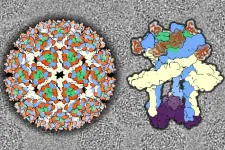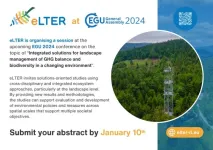(Press-News.org) The average cost of providing care to hospitalized COVID-19 patients increased five times faster than the rate of medical inflation during the first two years of the pandemic, at least partly because of the application of additional medical technologies over the period, according to a new RAND Corporation study.
Examining patients treated at academic medical centers across the nation, researchers found that the average cost of treatment for COVID-19 infection increased from $10,094 during the first weeks of the pandemic to $13,072 during March 2022.
Significant additional costs were associated with patients who had conditions such as obesity or a coagulation deficiency like hemophilia. Those who underwent extracorporeal membrane oxygenation, a breathing support treatment used later in the pandemic to sustain patients, had much higher costs.
The findings are published by the journal JAMA Network Open.
“Defining the cost of treating hospitalized people with COVID-19 is important to fully understand the financial impact of the pandemic and improving public health readiness for future challenges,” said Kandice A. Kapinos, the study’s lead author and a senior economist at RAND, a nonprofit research organization.
The COVID-19 pandemic placed unprecedented demands on medical services worldwide, with estimate cases exceeding 660 million. During the first two years of the pandemic in the U.S., 6.2 million Americans were hospitalized for treatment of the infection.
The peak demand for U.S. hospital services occurred during the Omicron variant surge from November 2021 to February 2022, when patients with COVID-19 accounted for more than one-fifth of hospital admissions and nearly one-third of intensive care beds.
While the pandemic caused many cancelled elective surgeries and other financial challenges for hospitals, relatively little research has probed the cost of providing care to the millions of COVID-19 patients treated in U.S. hospitals.
Researchers from RAND and partner institutions examined the cost of providing care to COVID-19 patients by analyzing information from a repository of clinical, administrative and financial details covering 97% of the nation’s academic medical centers -- more than 800 hospitals in total.
The analysis examined more than 1.3 million inpatient stays from March 2020 through March 2022 and analyzed the costs of providing care to patients, not the amount billed to insurers or the amounts paid. Researchers say these calculations best estimate the strain the illness put on hospitals.
More than 80% of the hospitalized patients entered through emergency departments, 13% received mechanical ventilation, 27% spent time in the ICU and 13% died. The adjusted cost for caring for COVID-19 patients increased by 26% during the two-year study period, compared to an overall 2% to 5% annual average medical cost inflation.
“The way doctors treated patients evolved as we learned about COVID-19,” Kapinos said. “Then once the vaccines became available, the makeup of patients entering hospitals began to change.”
Patients with the highest costs were more likely to have extracorporeal membrane oxygenation or mechanical ventilation but were not necessarily those who died.
Extrapolating the study’s findings to all of the 6.2 million COVID-19 hospitalizations in the U.S. during the study period, researchers suggest that the direct cost of caring for COVID-19 patients during the period could have reached $70 billion.
Support for the study was provided by The University of Texas Health Intelligence Platform.
Other authors of the study are Richard M. Peters, Jr., of the University of Texas at Austin; Robert E. Murphy and Ankita Podichetty of The University of Texas Health Science Center at Houston; Samuel F. Hohmann of Vizient; and Raymond S. Greenberg of The University of Texas Southwestern Medical Center, Dallas.
RAND Health Care promotes healthier societies by improving health care systems in the United States and other countries.
END
Cost of hospital care for COVID-19 patients increased during pandemic
Use of new technologies pushed up costs faster than medical inflation
2024-01-03
ELSE PRESS RELEASES FROM THIS DATE:
Epilepsy drug shows promise in slowing joint degeneration in osteoarthritis
2024-01-03
New Haven, Conn. — Yale researchers have identified a drug target that may alleviate joint degeneration associated with osteoarthritis, a debilitating condition that afflicts as many as 30 million people in the United States alone, which they report on Jan. 3 in the journal Nature.
Pain relievers and lifestyle changes, such as exercise and reduced excess weight, have long been the therapies most commonly used to treat the joint stiffness and pain caused by degenerative disease, but there ...
Researchers create first functional semiconductor made from graphene
2024-01-03
Researchers at the Georgia Institute of Technology have created the world’s first functional semiconductor made from graphene, a single sheet of carbon atoms held together by the strongest bonds known. Semiconductors, which are materials that conduct electricity under specific conditions, are foundational components of electronic devices. The team’s breakthrough throws open the door to a new way of doing electronics.
Their discovery comes at a time when silicon, the material from which ...
Study reveals clues to how Eastern equine encephalitis virus invades brain cells
2024-01-03
An atomic-level investigation of how Eastern equine encephalitis virus binds to a key receptor and gets inside of cells also has enabled the discovery of a decoy molecule that protects against the potentially deadly brain infection, in mice.
The study, from researchers at Washington University School of Medicine in St. Louis, is published Jan. 3 in the journal Cell. By advancing understanding of the complex molecular interactions between viral proteins and their receptors on animal cells, the findings lay a foundation for treatments and vaccines ...
Unraveling the mysteries of the Mongolian Arc: exploring a monumental 405-kilometer wall system in Eastern Mongolia
2024-01-03
New study sheds light on the previously overlooked Mongolian Arc—a monumental wall system in eastern Mongolia spanning 405 kilometers. This discovery not only reveals the significance of this ancient architectural marvel but also prompts crucial questions about the motives, functionality, and broader implications of such colossal constructions. Their findings contribute to a larger multidisciplinary project exploring historical wall systems and their socio-political, economic, and environmental impacts, marking a pivotal milestone in understanding ancient civilizations and their enduring legacies.
[Jerusalem, ...
Call for EGU24 General Assembly Abstracts
2024-01-03
The General Assembly 2024 of the European Geosciences Union (EGU) will be held at the Austria Center Vienna (ACV) in Vienna, Austria and online, from 14–19 April 2024. eLTER will organise the following session:
BG8.14: Integrated solutions for landscape management of GHG balance and biodiversity in a changing environment
Convener: Syed Ashraful Alam, Katri Rankinen, Thomas Dirnböck, Harry Vereecken, Olga Vindušková
The session is co-sponsored by eLTER.
The abstract submission deadline is Wednesday, 10 January 2024, 13:00 CET.
Society is placing increasing and potentially competing demands on our environment. ...
Unlocking sustainable water treatment: the potential of piezoelectric-activated persulfate
2024-01-03
As cities grow bigger and faster, water pollution is becoming a serious problem. We need good ways to clean the water. Traditional cleaning methods, Persulfate (PS)- Advanced Oxidation Processes (AOPs), are good at treating the bad stuff in the water, but they require a lot of energy and chemicals, like special light and metals ions. This is costly and environmentally harmful. It's urgent to find better and more eco-friendly ways to clean it.
In a recent study published in Volume 18 of the journal Environmental Science and Ecotechnology, scientists ...
On-demand conformation of an artificial cytoskeleton
2024-01-03
Peptide nanotubes are tubular-shaped structures formed by the controlled stacking of cyclic peptide components. These hollow biomaterials show inner and outer faces, allowing the control over their properties.
Led by Juan R. Granja, researchers from the Center for Research in Biological Chemistry and Molecular Materials (CiQUS) presented a novel kind of cyclic peptide that, when light-irradiated, induces the formation or desegregation of nanotubes on demand. At the appropriate wavelength, the peptide switches from a folded to a flat conformation. When the planar conformation is ...
Can artificial intelligence (AI) improve musculoskeletal imaging?
2024-01-03
(Boston)—While musculoskeletal imaging volumes are increasing, there is a relative shortage of subspecialized musculoskeletal radiologists to interpret the studies. Is AI the solution?
“With the ongoing trend of increased imaging rates and decreased acquisition times, a variety of AI tools can support musculoskeletal radiologists by providing more optimized and efficient workflows,” says corresponding author Ali Guermazi, MD, PhD, chief of radiology at VA Boston Healthcare System and professor of radiology and medicine at Boston University Chobanian & Avedisian School of Medicine.
In a new article in the journal Radiology, BU researchers provide ...
Case Western Reserve researchers land $1.125 million National Science Foundation grant to advance safer, faster and less expensive medical-imaging technology
2024-01-03
CLEVELAND—Diagnosing cancer today involves using chemical “contrast agents” to improve the accuracy of medical imaging processes such as X-rays as well as computed tomography (CT) and magnetic resonance imaging (MRI) scans.
But those agents can be expensive, take more time to use and pose potential health concerns.
With a new four-year, $1.125 million grant from the National Science Foundation (NSF), researchers at Case Western Reserve University hope to develop an artificial intelligence (AI) alternative ...
PTSD: the brain basis of susceptibility - a free webinar from the Brain & Behavior Research Foundation
2024-01-03
The Brain & Behavior Research Foundation (BBRF) is hosting a free webinar, “PTSD: The Brain Basis of Susceptibility” on Tuesday, January 9, 2024, at 2:00 pm ET. The presenter will be Nathaniel G. Harnett, Ph.D., Director of the NATE Lab at McLean Hospital and Assistant Professor in Psychiatry at Harvard Medical School. Dr. Harnett is also the recipient of a 2021 Young Investigator Grant. The webinar will be hosted by Jeffrey Borenstein, M.D., President & CEO of the Brain & Behavior Research Foundation, and host of the public television series Healthy Minds.
Register today ...
LAST 30 PRESS RELEASES:
Carbon monoxide, the ‘silent killer,’ becomes a boon for fuel cell catalysts
Historical geography helps researchers solve 2,700-year old eclipse mystery
SwRI expands High-Viscosity Flow Loop to test equipment moving heavy oils
Insilico Medicine and Atossa Therapeutics publish AI-driven study in Nature's Scientific Reports identifying (Z)-endoxifen as a potential therapeutic candidate for glioblastoma
An overlooked hormone eyed as deadly driver of postmenopausal breast cancer in women with obesity
Study links childhood vaccination to lower risk of drug-resistant bacteria
LLMs choose friends and colleagues like people
Gas stoves and nitrogen dioxide exposure
Beauty linked with metabolic costs of perceiving images
First Nations Australians twice as likely to be digitally excluded: report
Korea University study finds restless legs syndrome linked to Parkinson’s risk—dopamine treatment may be protective
Pusan National University researchers use AI to create optimized engine components that outperform human designs
Approximate domain unlearning: Enabling safer and more controllable vision-language models
Moths detect bat attack signals: Ultrasonic pulse rates drive distinct escape responses
Intimate partner violence injury patterns linked with suicidal behavior
Blood test shows obesity speeds Alzheimer’s development
New study supports the value of medical humanities in illuminating the root causes of health care disparities in Washington, DC
Uncovering the principle by which DNA replication initiation sites are determined in the human genome
Urban sprawl could deny 220 million people access to clean water by 2050
Researchers unveil first high-resolution maps of China's forest diversity patterns
Sun-watcher SOHO celebrates thirty years
Largest study of nose microbiome helps highlight those at risk of staph aureus infection
Structural racism and cultural misunderstanding compound grief for Black British and Black Caribbean communities, study finds
Water molecules in motion: Surprising dynamics on 2D materials
Alaknanda: JWST discovers massive grand-design spiral galaxy from the universe's infancy
Our brains recognise the voices of our primate cousins
Does the "use it or lose it" principle determine brain plasticity and shape how we age?
Dynamic duo of bacteria could change Mars dust into versatile building material for first human colonists
Lower prevalence of PSC among patients with IBD in Asia: Insights from a multinational study
Alcohol and ultrasonic irradiation: An effective CCl₄ decomposition tag team
[Press-News.org] Cost of hospital care for COVID-19 patients increased during pandemicUse of new technologies pushed up costs faster than medical inflation





